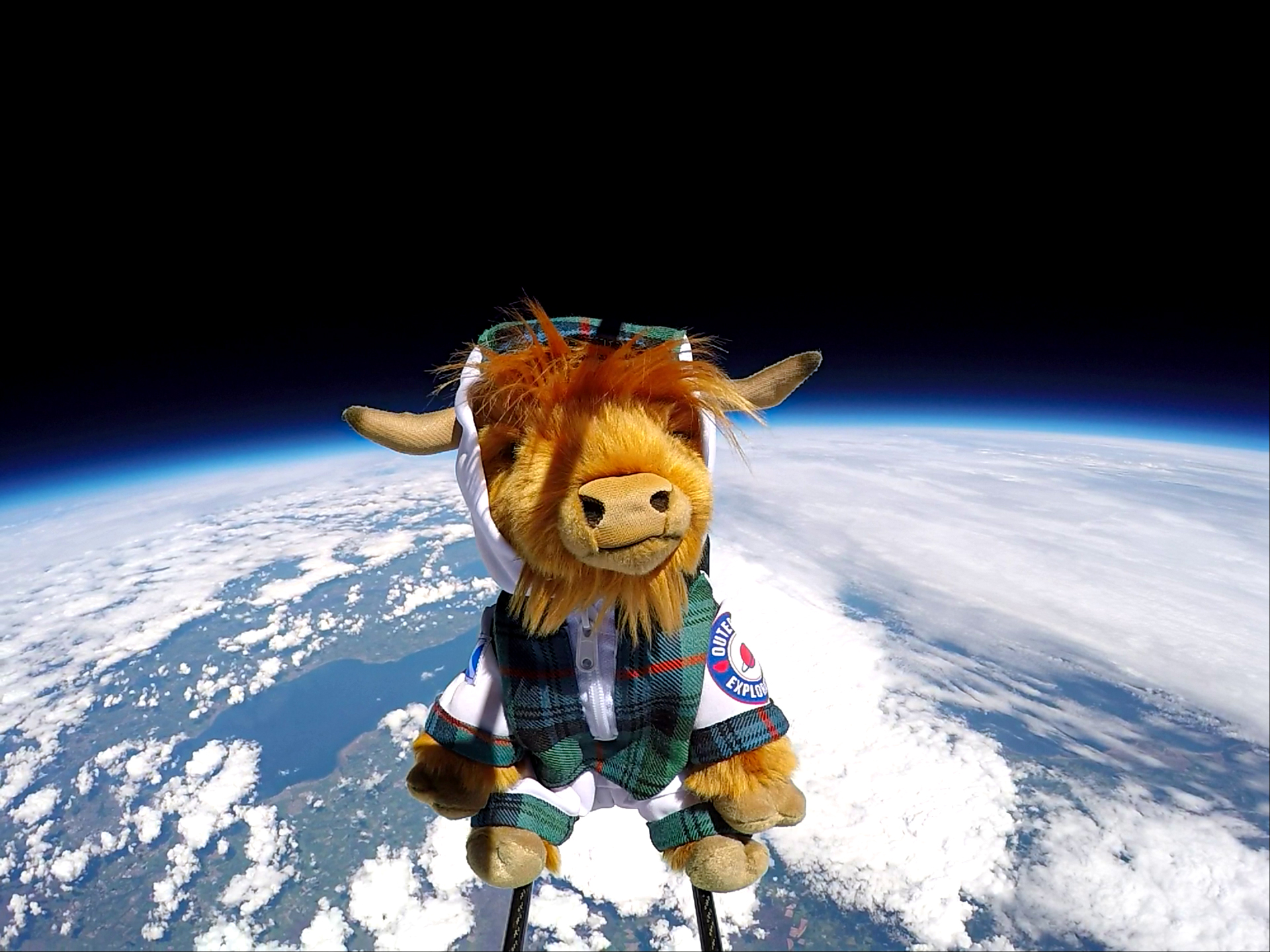A new tourism map highlighting Scotland’s links to space exploration and the first Moonwalk has been released on the 50th anniversary of the launch of Apollo 11 and to coincide with the 50th anniversary year of VisitScotland.
The Scotland is Out of this World trail is part of the new VisitScotland campaign of the same name which saw BuzzBò, the world’s first Highland Coosmonaut, soar 36,000 metres into near space wearing an Armstrong tartan spacesuit.
The national tourism organisation teamed up with Sent Into Space to send up the cuddly toy. Footage of him lifting off by weather balloon from Gilnockie Tower, the ancestral home of Clan Armstrong, and landing safely near Cranshaws in the Scottish Borders, has been released on Tuesday.
BuzzBò was named by 7-year-old Peter Lunan, of Dunblane, whose entry was picked by the national tourism organisation in its national Name the Highland Coosmonaut competition.

The name derives from Buzz Aldrin, the second man to walk on the Moon, and the Gaelic word for cow, Bò. The Highland Coosmonaut will be on display over the summer at the Edinburgh iCentre on the Royal Mile.
The Scotland is Out of this World trail features Scottish connections to each planet in the solar system, as well as fun facts and details of science centres and the best places to stargaze.
Highlights:
- Mars – Glenelg, Highlands: In 2012 the village twinned itself with a geological feature on Mars, also called Glenelg.
- Jupiter – Loch Airigh, Isle of Harris: The loch on the Isle of Harris in the Outer Hebrides portrays the planet Jupiter in the 1968 Stanley Kubrick directed film, 2001: A Space Odyssey.
- Uranus – Braemar, Aberdeenshire: The birthplace of Johann von Lamont, an astronomer and pioneer in geomagnetism, who calculated the mass of Uranus.
- Neptune – Jedburgh, Scottish Borders: The birthplace of 19th century science writer Mary Somerville who theorised that difficulties in calculating the position of Uranus may point to an undiscovered planet, which inspired the discovery of Neptune.
- Venus – Parton, Dumfries & Galloway: The resting place of 19th century physicist James Clerk Maxwell, whose name was given to Maxwell Montes, the planet’s only feature named after a man.
The Scotland is Out of this World campaign marks the 50th anniversary of the Apollo 11 mission and US astronaut Neil Armstrong’s historic walk on the lunar surface as well as the 50th anniversary of VisitScotland.
Ohio-born Neil Armstrong was said to be proud of his Scottish heritage. The ancestral home of Clan Armstrong is Langholm in Dumfries and Galloway and in 1972 he become the town’s first and only Freeman, declaring it at the ceremony his “home town”.
Dark skies have been identified by the travel guide publisher, Lonely Planet, as a key tourism trend for 2019. VisitScotland’s Insight team has therefore created a research paper examining the opportunities for tourism businesses in Scotland to engage with the trend.
Scotland is home to two International Dark Sky Parks, Galloway Forest Park in Dumfries and Galloway and Tomintoul and Glenlivet in Cairngorms National Park, a Dark Sky Island (Isle of Coll) and a Dark Sky Town (Moffat).
Malcolm Roughead, Chief Executive of VisitScotland, said: “For 50 years VisitScotland has helped position Scotland as a must-visit destination to audiences across the world. It is therefore fitting that in our anniversary year we set our sights even further and travelled into space in what can only be described as a truly ‘out of this world’ campaign.
“Scotland is Out of this World offered the opportunity to delve into the past and celebrate the country’s contribution to space exploration and astronomy and its ancestral links to one of the greatest moments in history.
“The new trail reveals some of the country’s stellar attractions and locations to visit to firmly cement Scotland’s place in astro-tourism. After all, our best views aren’t confined to our awe-inspiring landscapes, but reach up high into the night sky above as well.”
Alex Keen, Head of Communications and Launch Specialist from Sent into Space, said: “Launching at Gilnockie Tower was a real treat, given its connections to Clan Armstrong. It was fantastic to work with the team from VisitScotland and we were blown away by the beautiful and dramatic landscape we crossed as we pursued the Coosmonaut. Once the Coosmonaut was back in our hands, we were genuinely sad to have to leave and head back to England.”
Scotland is Out of this World was launched at Langholm Primary School in May and is one of a series of activities created to mark VisitScotland’s 50th anniversary. The Development of Tourism Act came into force in 1969 – the same year as the Moon landing – and an official Scottish Tourist Board was established with government funding.
Neil Armstrong, Buzz Aldrin and Michael Collins formed the three-man NASA mission which set off on 16 July 1969, to land on the surface of the Moon. On 20 July 1969, Armstrong and Aldrin touched down on the lunar surface.
For more on the campaign and to find out more about BuzzBò’s journey to near space, go to visitscotland.com/out-of-this-world
For more on Dark Skies & Astro-Tourism go to https://www.visitscotland.org/research-insights/about-our-visitors/interests-activities/outdoor-activities